Key Points
- The modern Windows 11 file explorer shows a modern command bar, whereas the legacy File Explorer in Windows 10 shows a ribbon menu that offers more options.
- You can bring back the legacy ribbon menu in Explorer from the Control Panel, using a registry file, or from StartAllBack and ExplorerPatcher.
Microsoft changed quite a lot of things when Windows 11 was launched, and File Explorer was one of them. The app windows were redesigned and the corners were rounded, but that did not make a functional impact. But the fact that the ribbon menu was stripped from File Explorer made quite a ruckus.
The ribbon menu in File Explorer, which is still present in Windows 10, gives a few options for the users to manage their files and organize their folders better. It gave direct buttons for actions, like mapping a network drive, managing the view styles, and sharing the content. However, the modern File Explorer only shows a command bar at the top with limited options, that are not very descriptive and without written button actions.
When the classic ribbon menu was converted into a modern interface, it was not welcomed by everyone. There are several posts across the internet where users are still trying to revert the modern File Explorer to the legacy version. After thoroughly going through all the possible methods to restore the classic ribbon menu in File Explorer, I came to find out that not all of them worked.
It seems like the methods used to work, but no longer work for the latest Windows 11 builds. Therefore, I have compiled a list of possible solutions that will let you bring back the legacy ribbon menu in File Explorer, both temporarily, and permanently.
If you prefer the classic ribbon menu inside the File Explorer on your Windows 11 computer, then the methods to restore it in this post will certainly work for you on the latest builds of Windows 11.
Table of Contents
Restore classic ribbon menu in File Explorer from Control Panel
One way to bring back the old ribbon menu inside File Explorer is from the Control panel, but it is not the method that you may be thinking of.
There is no setting or option in the Control Panel that will bring back the legacy ribbon menu. Instead, simply going back to a directory in the Control Panel opens the File Explorer with the classic ribbon menu. Here is how;
-
Press the Windows Key + R to launch the Run Command box.
-
Type in “control” and press Enter to open the Control Panel.
-
Make sure that the view is selected as “Category.”

View Control Panel by category -
Now click the “Up to Desktop” button (go back a directory in the hierarchy).
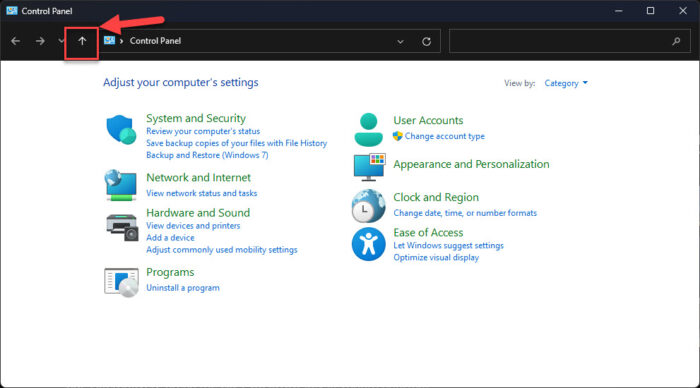
Go back to desktop
After performing the steps above, you will notice that the File Explorer will now open in the Desktop directory of your user account with the ribbon menu.
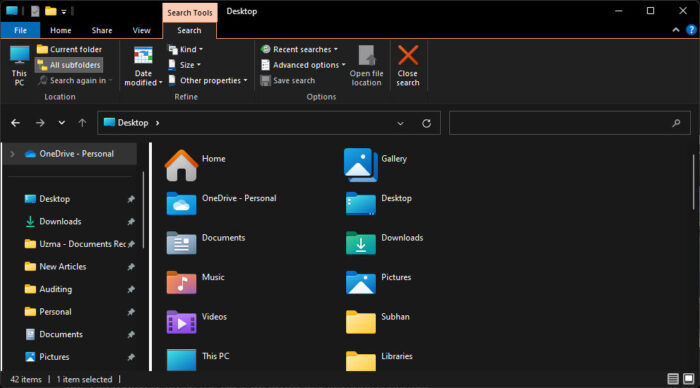
You can now continue to use this File Explorer window to browse your directories. However, if you open a new Explorer window from the taskbar or with any other method, it will open with the modern command bar instead of the ribbon menu. This is because the method given above is only temporary, and you will need to perform these steps every time you wish to have the ribbon menu in Explorer.
Alternatively, you can also open “Windows Tools” from the search bar or the Start menu and simply change your directory to have the ribbon menu in File Explorer. Here is how this method works:
-
Search for “Windows Tools” in the Start menu and open it.

Open Windows Tools -
In the “Windows Tools” window, click on any other directory in the navigation pane on the left.

Change the directory in Windows Tools
With these steps, the ribbon menu will be restored in File Explorer. However, like the previous method above, this too will only be temporary and will need to be performed each time you want the ribbon menu in File Explorer.
Open File Explorer with ribbon menu using shortcut
If you do not want to perform the steps above every time you want to launch File Explorer with a ribbon menu, then you can create a shortcut on your desktop that will do it for you. With this method, you can create a batch script and keep it on your desktop, and run it to launch Explorer with a ribbon menu.
Depending on which directory you want to open Explorer in, you can use the appropriate script given below:
Launch Explorer with ribbon menu to Desktop:
powershell.exe -nop -ep bypass -c "& {"Start-Process \"Control\"; $wshell = New-Object -ComObject wscript.shell; $null = $wshell.AppActivate(\"Control Panel\"); Start-Sleep 0.75; $wshell.SendKeys("'""^"lDesktop~"'")}"Launch Explorer with ribbon menu to Home:
powershell.exe -nop -ep bypass -c "& {"Start-Process \"Control\"; $wshell = New-Object -ComObject wscript.shell; $null = $wshell.AppActivate(\"Control Panel\"); Start-Sleep 0.75; $wshell.SendKeys("'""^"lHome~"'")}"Launch Explorer with ribbon menu to OneDrive:
powershell.exe -nop -ep bypass -c "& {"Start-Process \"Control\"; $wshell = New-Object -ComObject wscript.shell; $null = $wshell.AppActivate(\"Control Panel\"); Start-Sleep 0.75; $wshell.SendKeys("'""^"lShell:OneDrive~"'")}"Launch Explorer with ribbon menu to This PC:
powershell.exe -nop -ep bypass -c "& {"Start-Process \"Control\"; $wshell = New-Object -ComObject wscript.shell; $null = $wshell.AppActivate(\"Control Panel\"); Start-Sleep 0.75; $wshell.SendKeys("'""^"lThis PC~"'")}"After having copied the code for the preferred location, use these steps to create a batch file and then use it to launch Explorer with a ribbon menu:
-
Open Notepad and paste the script inside it.
-
Click File and then click “Save as.”

Save the code -
Change “Save as type” to “All files.”
-
Enter a custom name for the shortcut followed by “.bat“, and then click Save.
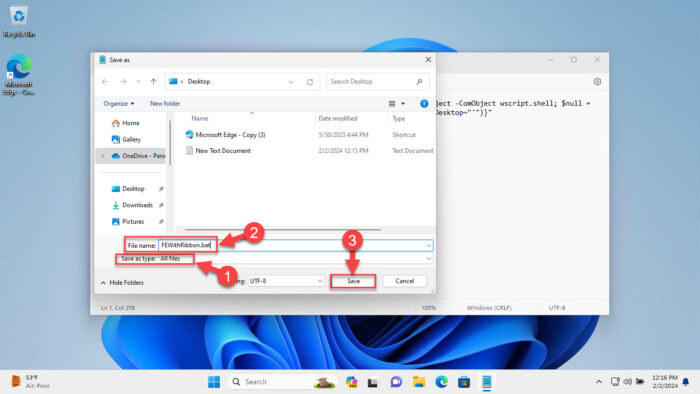
Save the batch file -
Now simply run the batch file to launch File Explorer with a ribbon menu.
Performing the steps above will automate opening File Explorer with a ribbon menu using the Control Panel method, which we had discussed earlier.
Restore classic ribbon menu in File Explorer using registry file (Permanently)
If you want to restore the ribbon menu inside File Explorer indefinitely, then I suggest that you use this approach which makes changes to the Windows Registry. This way, you will not need to use a shortcut or go through the Control Panel every time you want to use the legacy ribbon menu on your Windows 11 PC.
The compiled registry files below will make the necessary changes to your Windows Registry to restore the classic ribbon menu in Explorer. However, note that this only makes changes for the current user account you are logged in with.
Note: Although the registry files are tested and safe, it is recommended that you create a system restore point or a complete system image backup before proceeding forward with the process. You can also use our top selection of disk imaging and backup software so you never lose your data or operating system again.
Click on the respective link below to restore the legacy ribbon menu or bring back the modern Explorer interface with a command bar to download the registry file:
 Restore Legacy File Explorer With Ribbon Menu (563 bytes, 110 hits)
Restore Legacy File Explorer With Ribbon Menu (563 bytes, 110 hits)
 Apply Modern File Explorer With Command Bar.zip (400 bytes, 104 hits)
Apply Modern File Explorer With Command Bar.zip (400 bytes, 104 hits)
After downloading the file, extract its contents and run the registry file. After running it, restart the computer, and the changes will be applied.
Restore classic ribbon menu in File Explorer using third-party apps
If the methods above do not work for you, then you can use trusted third-party applications that are for free, to restore the classic ribbon menu in File Explorer.
Restore legacy ribbon menu in File Explorer with StartAllBack
The StartAllBack application is used to tackle the annoyances many people face while using the Windows OS. One of those is restoring the legacy ribbon menu in File Explorer. Here is how you can use StartAllBack to bring back the ribbon menu:
-
Open the StartAllBack website and download the app.

Download StartAllBack -
Run the downloaded setup file.
-
Select either of the following installation options according to your preferences:
- Install for me
- Install for everyone
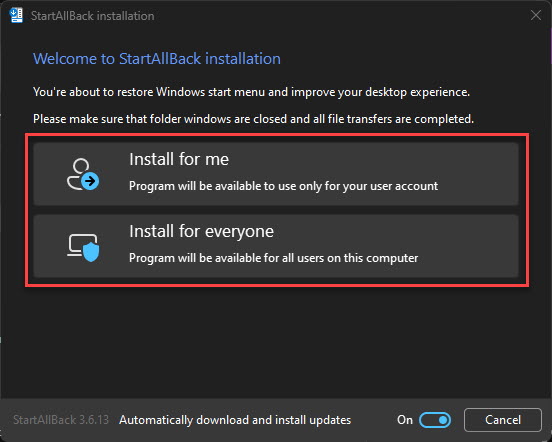
Select installation preferences The application will now be installed almost immediately, and you will notice some changes in the taskbar.
Note: You can undo the automatic changes from within the StartAllBack app.
-
Open the StartAllBack app. Although it should launch automatically, if it doesn’t, right-click on the Start menu and then click Properties to open it.
-
Switch to the Explorer tab on the left and select “Win10 Ribbon UI.”
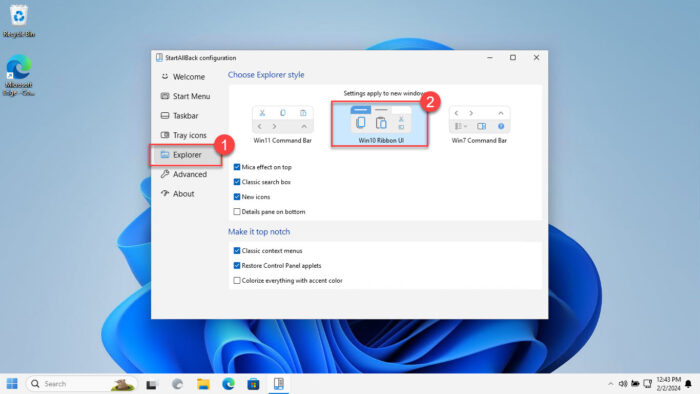
Restore the Windows 10 ribbon menu in Explorer with StartAllBack
After performing the steps above, if you launch File Explorer, you will see the ribbon menu. This setting will remain indefinitely, till you do not change the setting from StartAllBack, or uninstall the app itself.
Restore legacy ribbon menu in File Explorer with ExplorerPatcher
ExplorerPatcher is another open-source third-party tool used to modify and manipulate Windows components. Here is how it can be used to restore the legacy ribbon menu in File Explorer:
-
Download ExplorerPatcher from here.

Download ExplorerPatcher -
Run the .EXE file to install the tool. No installation wizard will open.
Note that the screen may flicker and the taskbar behavior might change during the installation.
-
Open the app by right-clicking the taskbar and then click Properties.
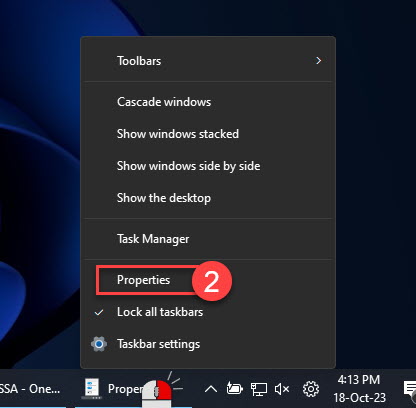
Open the ExplorerPatcher software -
Switch to the “File Explorer” tab.
-
Expand the drop-down menu in front of “Control Interface” and select “Windows 10 Ribbon.”
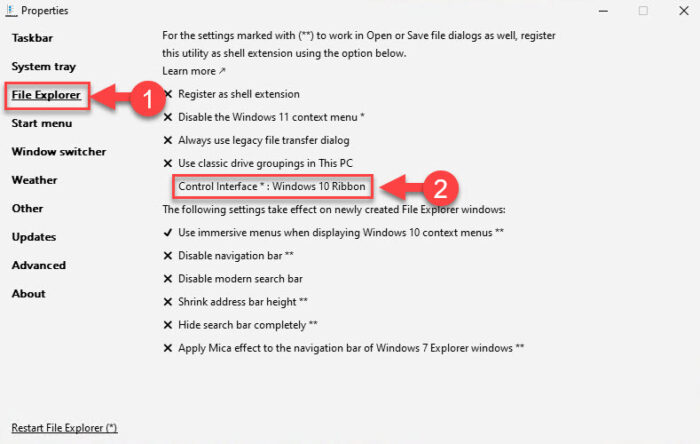
Restore Windows 10 ribbon menu in Explorer with ExplorerPatcher
ExplorerPatcher will also change the modern command bar in File Explorer to the legacy Windows 10 ribbon menu using these steps.
This concludes all the effective methods that still work on Windows 11 that will bring back the ribbon menu in File Explorer.
Conclusion
The internet may show you other methods to restore the ribbon menu inside the File Explorer. For example, it may tell you to create a string value inside the “Batch” key in the Windows Registry. Although such methods used to work, with the recent Windows updates, they do not anymore.
However, the methods given in this post to bring back the Windows 10 classic ribbon menu in File Explorer have been tested and work a hundred percent. That said, it is still possible that Microsoft will roll out another update and these methods become obsolete as well.



